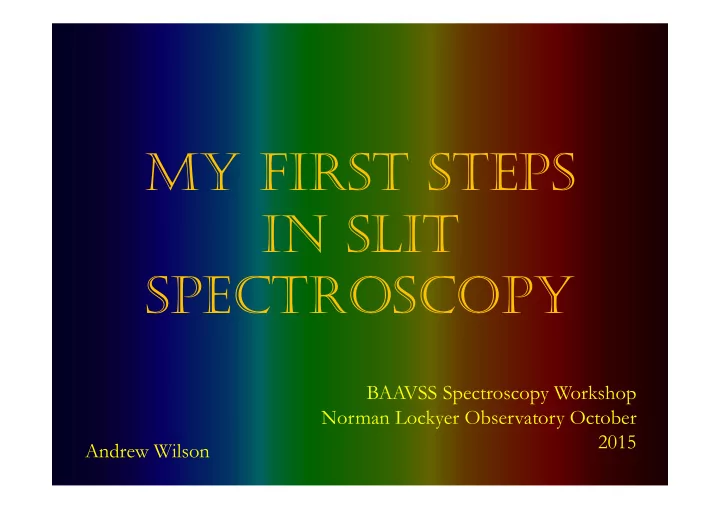

MY FIRST STEPS IN SLIT SPECTROSCOPY BAAVSS Spectroscopy Workshop Norman Lockyer Observatory October 2015 Andrew Wilson
Overview • My choice of spectrograph, camera and telescope • Getting started and basic processing • Some of the problems I’ve overcome • More advanced processing • Interspersed with examples of my spectra 2
Spectrographs I’ve Used Littrow Spectrographs - L200 & LHIRES III Both use interchangeable diffraction gratings 3
SHEYAK INSTRUMENTS LHIRES III LHIRES III – Littrow Configuration LHIRES III user manual 4
L200 Ken Harrison design built by JTW • Multiple gratings • Optimised for R3000 = 2 Angstroms at H- Alpha 5
LHIRES III Shelyak Instruments • Multiple gratings • Optimised for R17000 = 0.35 Angstroms at H- Alpha 6
Camera Choice • Imaging camera – Starlight Xpress SXVR-H694 • Black and white • Cooled • High sensitivity • Guide camera – Starlight Xpress Lodestar • Sensitive • Low noise • Light 7
My Old Observatory 14” F10 Meade AP1200 GTO 8
My New Observatory 10” F8 RC AP1200 GTO 9
Preparation • First of all practice in daylight and indoors – A good idea to note the micrometre readings for different lines • Spectroscope setup (check at telescope) – Focus the guide camera on the slit May only need to do once – Select the wavelength – Focus main camera using the neon spectrum 10
At the Telescope • Focus the telescope on a star – Can do by looking at the guide star image – Refine by looking at the spectrum and focus until counts or signal are highest – May need to nudge star back and forth to centre on slit • Test spectrum to make sure everything is OK 11
Align Spectra Camera Horizontal Axis Not aligned (Castor H-alpha at high resolution) Aligned (CH Cygni at low resolution) 12
Locating the Star Planetarium software BAAVSS Charts 13
An imaging run – Getting the spectra • Target star – Find the target star – Take a neon spectrum – Position the star on the slit – Track the telescope on a guide star – Take star spectrum images – If long run then take another neon spectrum 14
Processing a Spectrum Basic Processing • Calibrate all the images – Dark frames – Bias frames (if required) – Hot pixel removal • Combine the images • Correct spectra for “tilt” and “slant” • Wavelength calibrate the spectrum 15
Kappa Cassiopeia NASA 16
Kappa Cassiopeia Low Resolution – No Response Correction 17
Kappa Cassiopeia Medium Resolution – No Response Correction 18
Kappa Cassiopeia High Resolution – No Response Correction 19
The Allen Telescope University of London Observatory 24” Richey-Chretien 20
Kappa Cassiopeia Mill Hill Observatory 1993 21
Processing a Spectrum Further Image Calibration • Cosmic ray removal • Flat fields – Removes image artefacts dependent on the spectrum position on the imaging chip 22
Processing a Spectrum Response Profile – Instrumental and Atmospheric Correction Take a spectrum of a standard A type star • – Close to air mass (altitude) of the target star Divide this by a professional reference spectrum of the same star • Smooth the resultant curve to remove minor artefacts • This is the response profile! • Used to correct the spectrum of the target star for your equipment • and the Earth’s atmosphere 23
Rho Persei Instrument and Atmospheric Response Corrected but no Flat Field Red giant with a temperature of about 4000K and a semiregular variable star 24
Kappa Cassiopeia Flat Field & Response Corrected 25
Hydrogen Alpha Line B Stars in Cassiopeia B Star Temperatures: 15,500K~28,000K 26
Refining LHIRES III Setup Main Mirror Position • Adjusting the main mirror position on the LHIRES III to optimise the light throughput • Low • Middle • High 27
Kappa Cassiopeia Optimising the Spectrograph Adjusting LHIRES III mirror position along with telescope and guide camera focus 28
Shift in the Continuum • Over a 20 minute period the recorded continuum of the reference star has shifted. • I suspect this was due to sampling a shifting section of the star’s 29 seeing disk which is subject to atmospheric dispersion.
Atmospheric Dispersion Airy disc Not a point source and will be subject to blurring by the atmosphere Atmospheric Dispersion Difference parts of the seeing disc will preferentially contain stronger red of blue light from the star 30
Chi Cygni Mira Type Variable Low resolution response corrected 31
Chi Cygni H-Alpha Mira Type Variable High resolution response corrected 32
AG Pegasi Symbiotic Star – Red Giant and White Dwarf Low resolution response corrected 33
AG Pegasi H-Alpha Symbiotic Star – Red Giant and White Dwarf High resolution response corrected 34
The Orion Nebula 35
Vega High Resolution & Fully Calibrated 36
Comet Lovejoy 37
Processing a Spectrum Further Enhancements - Future Challenges! • Improved wavelength calibration – Use telluric lines around H-Alpha • Flux calibration – Gives the actual energy received from the star at different wavelengths • Removal of interstellar reddening – Corrects the spectrum for the effects of interstellar dust that absorbs more blue light than red light 38
Future Projects • Variable stars of all types • Radial velocity measurements • Galaxy rotation • Be stars • Detailed analysis of nebulae emission line 39
Further Information Wikimedia Commons used as source for many images: • http://commons.wikimedia.org/wiki/Main_Page Spectroscopy Yahoo Groups • https://groups.yahoo.com/neo/groups/astronomical_spectroscopy/info https://groups.yahoo.com/neo/groups/spectro-l/conversations/messages ARAS – Astronomical Ring for Access to Spectroscopy • http://www.spectro-aras.com/forum/index.php British Astronomical Association Variable Star Section • http://www.britastro.org/vss/ Online Astronomy Society Astronomical Spectroscopy Facebook Group • https://www.facebook.com/groups/362613490511970/ Me – Andy Wilson: barnards.star12@gmail.com 40
Recommend
More recommend